Monitor "ENGINE SPEED SENSOR" parameter on the Scantool.
Specification : 800±50RPM at idle
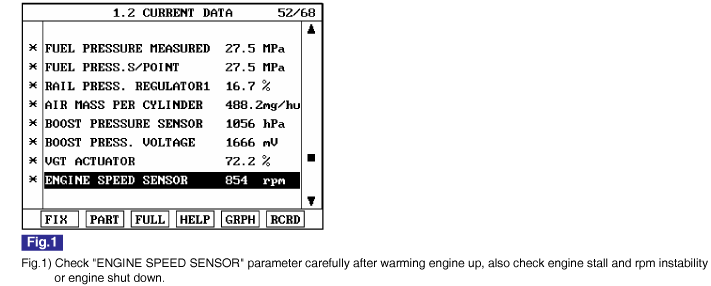
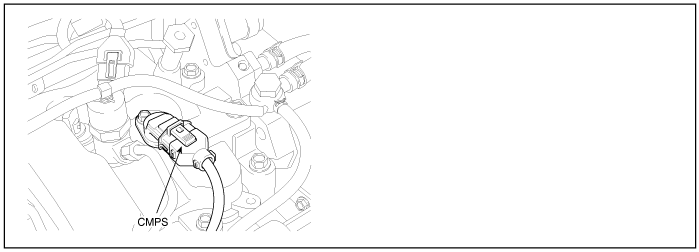
Cam Shaft Position Sensor(CMPS) is hall sensor type. Sensing the teeth attatch at the end of exhaust cam shaft, CMPS detects rotation of Cam shaft (1 signal per 1 lotation)As Cam shaft rotates once while Crank shaft does twice, CMPS referrence point generates once while CKPS' do twice.As this signal inputted to ECM, it distinguishes crank angle and the cylinder which requires fuel injection in order to determine injection sequence and duration.
P0341 is set when CMPS reference point is detected more or less than twice while CKPS reference point is recognized 4 times. This code is due to temporary poor connection or short to ground in CMPS circuit. CMPS component failure.
Item | Detecting Condition | Possible Cause | ||
DTC Strategy | ● Signal monitoring | ● CMPS circuit ● CMPS component | ||
Enable Conditions | ● During accelerating and turning engine "ON" | |||
Threshold Value | ● When RPM from CMPS correlates with RPM from CKPS abnormally. | |||
Diagnostic Time | ● Crank Shaft rotates 4 times | |||
Fail Safe | Fuel cut | YES | ||
EGR Off | NO | |||
Fuel Limit | NO | |||
Check Lamp | YES | |||


ECM recognizes HIGH signal as LOW signal when CMPS signal drops below 2.0V and LOW signal as HIGH signal when CMPS signal rises above 3.8V.
V0 - the Minimum voltage of LOW signal does not drop below 0.0V due to the hall sensor inside resistance. When the Minimum voltage of LOW signal is above 0.6V during signal waveform inspection, check excessive resistance inside of CMPS component or in ground circuit.
Sensor Type | Output Signal Characteristic | Air Gab | Low RPM Minimum Detecting Voltage | High RPM Minimum Detecting Voltage |
Hall effect type | 0V~5V Digital signal output | 1.25mm | below 2.0V | above 3.8V |
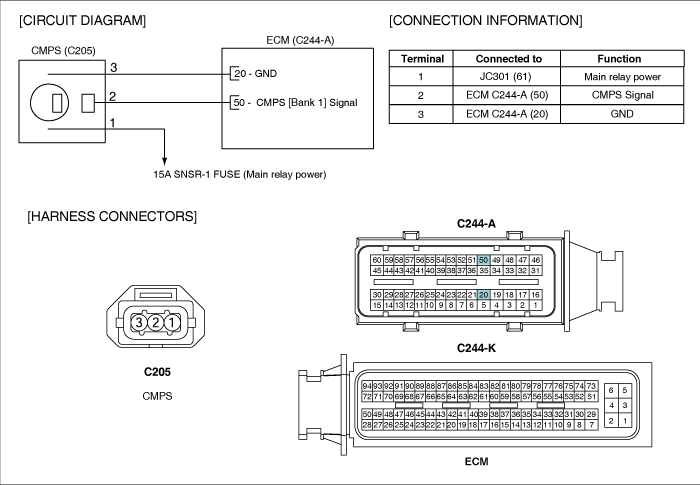
Connect Scantool to Data Link Connector (DLC).
Warm engine up to normal operating temperature.
Turn "OFF" electrical devices and A/C.
Monitor "ENGINE SPEED SENSOR" parameter on the Scantool.
Specification : 800±50RPM at idle

Electrical systems consist of a lot of harness and connectors, poor connection of terminals can cause various problems and damge of component.
Perform checking procedure as follows.
Check damage of harness and terminals : Check terminals for contact resistance, corrosion and deformation.
Check connecting condition of ECM and component connector : Check terminal seperation, damage of locking device and connecting condition between terminal and wiring.
Disconnect the pin which requires checking at male connector and insert it to the terminal at female connector for checking connecting condition. ( after checking, reconnect the pin at correct position. )
Is the problem found?

▶ Repair the trouble causing part and go to "Verification of Vehicle Repair".

▶ Go to "Power Circuit Inspection".
IG KEY "OFF", ENGINE "OFF".
Disconnect CMPS connector.
IG KEY "ON".
Measure the voltage of CMPS connector terminal 1.

Specification : 11.0V~13.0V ( Main relay "ON" power )
Is the measured voltage within the specification?

▶ Go to "Signal Circuit Inspection".

▶ Repair open in Main relay power circuit and fuse, and go to "Verification of Vehicle Repair".
[Check open in E/R JUNCTION BOX 15A SNSR1 FUSE and related circuit.]
※ If the fuse is damaged again after replacing the damaged fuse, repair short to ground in Main relay power circuit.
Check CMPS signal voltage
IG KEY "OFF", ENGINE "OFF".
Disconnect CMPS connector.
IG KEY "ON".
Measure the voltage of CMPS connector terminal 2.
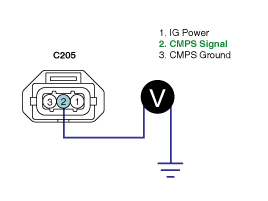
Specification : 4.8V~5.1V
Is the measured voltage within the specification?

▶ Go to "Ground Circuit Inspection".

▶ Go to "Check open in signal circuit" as follows.
Check open in signal circuit
IG KEY "OFF", ENGINE "OFF".
Disconnect CMPS connector and ECM connector.
Check continuity between CMPS connector terminal 2 and ECM connector(C244-A) terminal 50.
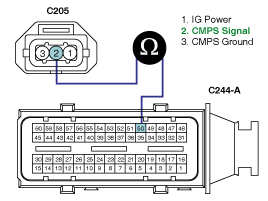
Specification : continuity ( below 1.0Ω )
Is the measured resistance within the specification? (Is continuity confirmed?)

▶ Go to "Check short to ground in signal circuit" as follows.

▶ Repair open in the circuit between CMPS connector terminal 2 and ECM connector terminal 50 and go to "Verification of Vehicle Repair".
IG KEY "OFF", ENGINE "OFF".
Disconnect CMPS connector.
IG KEY "ON".
Check the voltage of CMPS connetor terminal 2. [ TEST "A" ]
Check the voltage between CMPS connetor terminal 2 and 3. [ TEST "B" ]
( terminal 2 : Check + prove , terminal 3 : Check - prove )

Specification : [TEST "A"] Voltage - [TEST "B"] Voltage = below 200mV
Is the measured voltage within the specification?

▶ Go to "Component Inspection".

▶ When "B" voltage is not detected : Repair open in ground circuit and go to "Verification of Vehicle Repair".
▶ When the voltage difference between "A" and "B" is above 200mV : Eliminate the causes of excessive resistance and go to "Verification of Vehicle Repair".
Cam shaft detecting teeth inspection
IG KEY "OFF", ENGINE "OFF".
Disconnect CMPS connector.
Disconnect CMPS.
Check the condition of Cam shaft detecting teeth through CMPS mounting hall.
Is abnormal deformation of Cam shaft detecting teeth found?

▶ Replace Cam shaft assy' or Cylinder head assy' and go to "Verification of Vehicle Repair".

▶ Go to "CMPS waveform Inspection" as follows.
CMPS waveform inspection
IG KEY "OFF", ENGINE "OFF".
Connect CMPS connector.
Connect Oscilloscope to CMPS connector terminal 2.
Monitor if CMPS waveform is outputted normally as cranking or turning engine "ON".
Specification : Refer to "Signal waveform & Data" of "General Information".
Is CMPS waveform displayed correctly?

▶ Go to "Verification of Vehicle Repair".

▶ Replace CMPS and go to "Verification of Vehicle Repair".
After a repair, it is essential to verify that the fault is corrected.
After connecting Scantool select "DIAGNOSTIC TROUBLE CODES(DTCs)" mode.
Clear recorded DTC using Scantool.
Drive the vehicle within DTC "Enable conditions" in "General information".
After selecting "DIAGNOSTIC TROUBLE CODES(DTCs)" mode and check if DTC is recorded again.
Are any DTCs recorded ?

▶ Go to the DTC guide of recorded NO. in Scantool.

▶ System operates within specification.